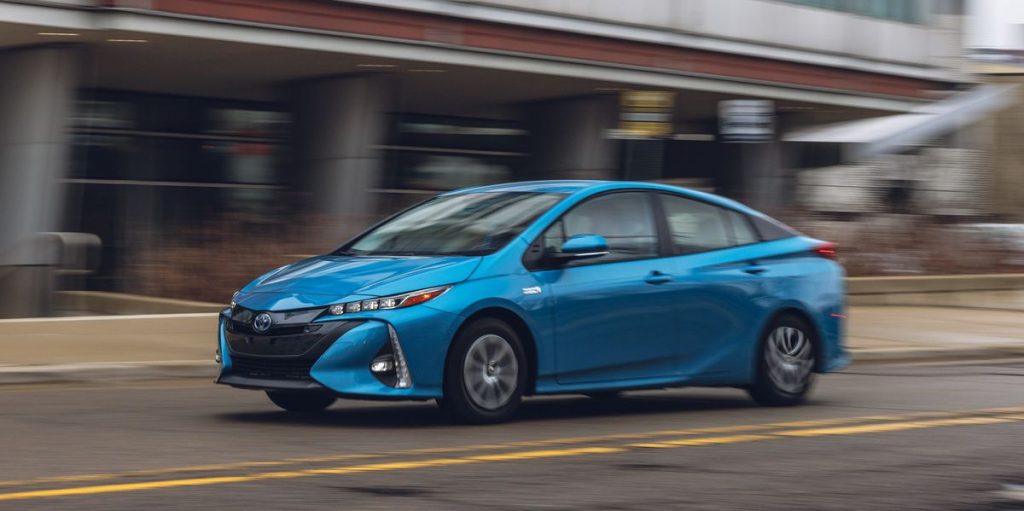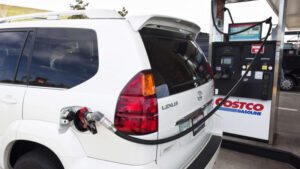Tested: 2022 Toyota Prius Prime's Time Has Come and Gone

Plug-in-hybrid vehicles have become increasingly common in recent years, with offerings as diverse as the Chrysler Pacifica hybrid minivan and the Ferrari SF90 Stradale supercar. Unsurprisingly, perhaps, it was the brand best known for regular hybrids, Toyota, that was a pioneer in the space, first with the Prius plug-in in 2012, followed by the Prius Prime.
The Prius Prime launched as a 2017 model, and in the five years since it hasn’t changed much. The Prime is marketed as a separate model from the regular Prius, and in addition to its modified powertrain, it has slightly different—but equally bizarre—exterior styling. Back when Toyota was designing the Prime, it evidently was taken with the idea that a key element behind the Prius’s popularity was its outside-the-mainstream appearance. So, this version ventured even further afield, adding new creases to the Prius’s peaked profile, introducing a double-bubble roofline, and bracketing the lower air intake with huge vertical fog lights.
Michael SimariCar and Driver
The oddities continue inside. The digital instrumentation is offset in the center of the dash outside the driver’s normal line of sight, and the shallow screen doesn’t offer much in the way of customization. A head-up display that’s directly in front of the driver compensates for the weird placement of the instrument cluster, but it’s exclusive to the Limited trim. The shifter is like that of the regular Prius, a stubby little lever that moves through an unusual double-J pattern. Physical knobs and buttons are mostly banished. Instead, nearly all controls are unintuitive capacitive touchpoints, even for audio volume and temperature adjustment.
HIGHS: EPA-combined 54 mpg, can recharge via a standard outlet, well-equipped for the price.
Michael SimariCar and Driver
The base LE has a 7.0-inch center touchscreen, while the XLE and Limited models (like our test car) get an 11.6-inch vertical display. Either way, navigation is included, as are smartphone mirroring and Amazon Alexa integration. Despite the bigger screen’s large amount of available real estate, most of its touchpoints are tiny, making it tough to hit your target on the first try—and certainly not without taking your eyes off the road. Performing some simple tasks, such as adjusting the fan speed, takes multiple screen taps.
All Prime models have interiors free of animal products, with synthetic leather in the Limited model. The seating position is low, and the dead pedal for the driver’s left leg is rather close. The view out over the long dash is framed by the A-pillars, and the bar in between the two pieces of glass on the hatchback obstructs the view to the rear. The rear seat now has seatbelts for three but is more realistically roomy enough for two passengers, and they should mind the sloping roofline when getting in. Behind the rear seats is a modest 20 cubic feet of luggage space, and the load floor is high. The regular Prius has a roomier cargo hold (27 cubic feet), as does the Hyundai Ioniq PHEV (23 cubic feet).
Michael SimariCar and Driver
Like the regular Prius, the Prius Prime is all about fuel economy. It boasts EPA estimates of 53 mpg city, 55 mpg highway, and 54 mpg combined. That tops all plug-in hybrids, although the regular Prius does about as well, with EPA combined estimates of 52 or 56 mpg, depending on trim level. (Unlike the Prime, the regular Prius also offers an all-wheel-drive variant good for 49 mpg.) We saw 45 MPGe in our 200-mile highway fuel-economy test (starting out with a full battery) and averaged 48 MPGe overall. When you turn off the car, the dashboard display gives you an eco-driving score on a 1-100 scale, usually accompanied by one attaboy message (“Good Steady Driving”) and one noting how you can do better (“Ease Accelerator Use”), delivered with a few piano notes as a musical backdrop.
LOWS: Listless acceleration, annoying touch controls, short EV range.
The Prime’s plug-in-hybrid powertrain combo of a 1.8-liter Atkinson-cycle four-cylinder engine and two motor-generators musters just 121 horsepower, and the car’s acceleration is predictably unhurried. At our test track, the Prime dragged itself to 60 mph in 10.3 seconds, which makes it slower than any car we tested last year or in 2020. It’s also slower than the Ioniq PHEV. The quarter-mile passed in an equally languid 17.7 seconds at 78 mph. That’s using the engine and electric motors. Set to EV mode, those times were even longer.
Michael SimariCar and Driver
Out on the road, the planetary gearset behaves like a continuously variable automatic transmission, sending the engine revs soaring, with attendant droning whenever you call for acceleration. Eco, Normal, and Power drive modes mostly just determine how far you have to press the accelerator before the powertrain responds.
If the battery has sufficient charge, the car starts out driving as an EV, which is actually more pleasant since the accelerator response is linear and the engine stays silent. Unfortunately, the Prius Prime can’t be driven as an EV for long. With an estimated 6.2 kWh worth of energy for the lithium-ion battery pack, the Prime offers a modest 25 miles of EV range, according to the EPA; we got 21 miles on our highway test. Most newer PHEVs do better, including the Ioniq (29 miles), the Hyundai Tucson (33 miles), and the Ford Escape (37 miles).
Michael SimariCar and Driver
To get a sense of how far PHEV powertrains have come since the Prius Prime made its debut, one need only look across the Toyota showroom. The RAV4 Prime, introduced last year, features a 2.5-liter engine, three electric motors, all-wheel drive, and a much larger battery. The RAV4 Prime’s 302 horsepower lays waste to the Prius Prime in acceleration, zooming to 60 mph in 5.4 seconds. Its official fuel economy of 38 combined mpg can’t match the Prius, but the RAV4 is much more likely to use no gas at all in around-town driving, as it can travel an estimated 42 miles solely on battery power.
There is one advantage to the Prius Prime’s small battery—its easy home recharging. The Prime can be plugged into a conventional 120-volt wall outlet, which refills the battery in about five-and-a-half hours. A 240-volt socket can also be used and cuts that time to two hours.
Beyond its penurious powertrain, the Prime’s disinterested driving demeanor extends to its steering, which is light and numb. The low-rolling-resistance tires, predictably, don’t shine on the skidpad, where we measured 0.80 g of lateral grip and recorded a stopping distance of 184 feet from 70 mph. Brake-pedal modulation, though, is not bad for a hybrid. The Prius Prime also ably masks lesser bumps in the road, although large potholes send a disturbance through the body structure.
Michael SimariCar and Driver
The Prius Prime starts at $29,245 for the LE, climbing to $31,025 for the XLE and $35,025 for the Limited. Those figures are a couple grand more than you’d pay for the regular Prius. For now, the Prime is eligible for a $4502 federal tax credit, but that is expected to start being phased out later this year. (The phase-out varies with each automaker, depending on the total number of PHEVs and EVs it has sold.)
Car companies are rapidly adding PHEVs as they work to electrify their lineups. As they do, the focus of plug-in hybrids is changing, moving from fuel economy to performance—both in terms of acceleration and electric-only range. The Prius Prime lags in both those metrics. And while it bests other PHEVs in fuel economy, it isn’t materially better than the regular Prius. Which leaves not much reason to step up to the Prime.
Specifications
Specifications
2022 Toyota Prius Prime Limited
Vehicle Type: front-engine, front-motor, front-wheel-drive, 5-passenger, 4-door hatchback
PRICE
Base/As Tested: $35,025/$35,284
Options: carpet floor and cargo mats, $259
POWERTRAIN
DOHC 16-valve 1.8-liter Atkinson-cycle inline-4, 95 hp, 105 lb-ft + 2 AC motors (combined output: 121 hp; 6.2-kWh lithium-ion battery pack (C/D est); 3.3-kW onboard charger)
Transmission: direct-drive
CHASSIS
Suspension, F/R: struts/multilink
Brakes, F/R: 10.0-in vented disc/10.2-in disc
Tires: Dunlop Enasave 01 A/S
195/65R-15 91S M+S
DIMENSIONS
Wheelbase: 106.3 in
Length: 182.9 in
Width: 69.3 in
Height: 57.9 in
Passenger Volume: 91 ft3
Cargo Volume: 20 ft3
Curb Weight: 3440 lb
C/D TEST RESULTS
60 mph: 10.3 sec
1/4-Mile: 17.7 sec @ 78 mph
100 mph: 32.7 sec
Results above omit 1-ft rollout of 0.4 sec.
Rolling Start, 5–60 mph: 10.5 sec
Top Gear, 30–50 mph: 4.6 sec
Top Gear, 50–70 mph: 7.0 sec
Top Speed (gov ltd): 102 mph
Braking, 70–0 mph: 184 ft
Roadholding, 300-ft Skidpad: 0.80 g
C/D FUEL ECONOMY
Observed: 48 MPGe
75-mph Highway Driving, EV/Hybrid Mode: 112 MPGe/45 MPGe
Highway Range, EV/Hybrid mode: 21/510 mi
EPA FUEL ECONOMY
Combined/City/Highway: 54/53/55 mpg
Combined Gasoline + Electricity: 133 MPGe
EV Range: 25 mi
C/D TESTING EXPLAINED
A car-lover’s community for ultimate access & unrivaled experiences. JOIN NOW
This content is created and maintained by a third party, and imported onto this page to help users provide their email addresses. You may be able to find more information about this and similar content at piano.io


